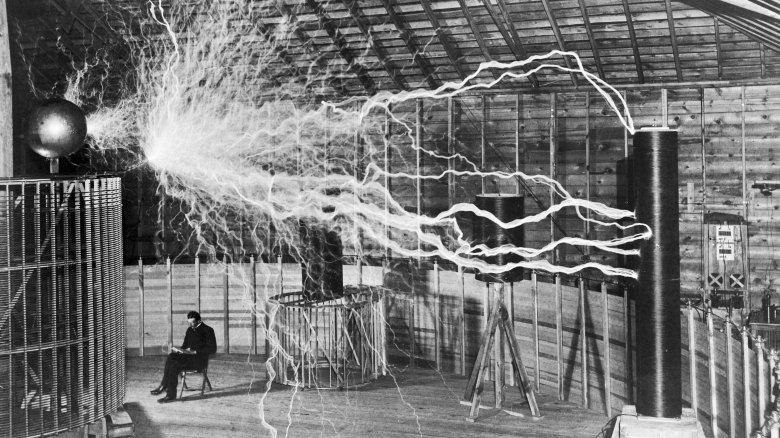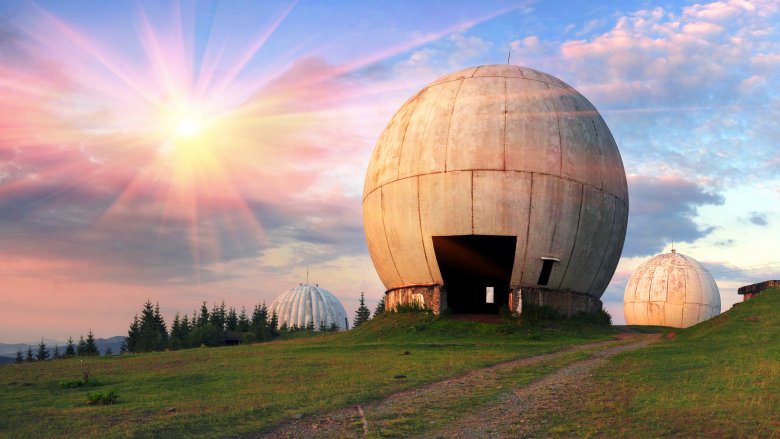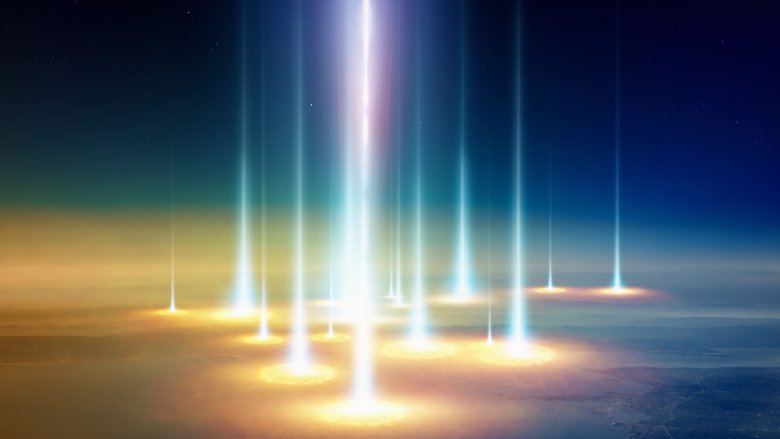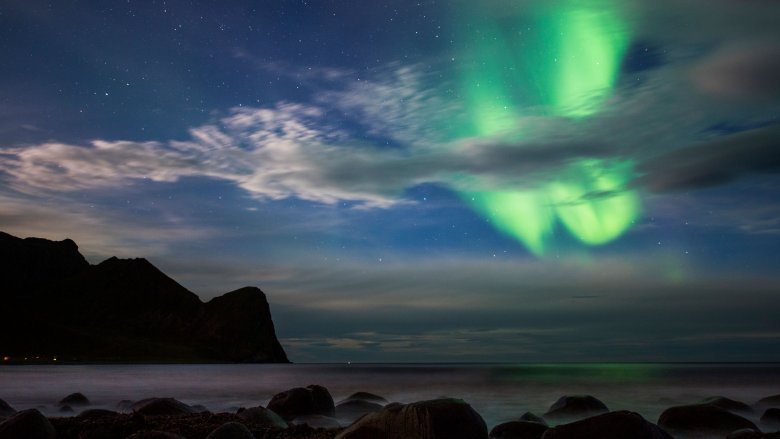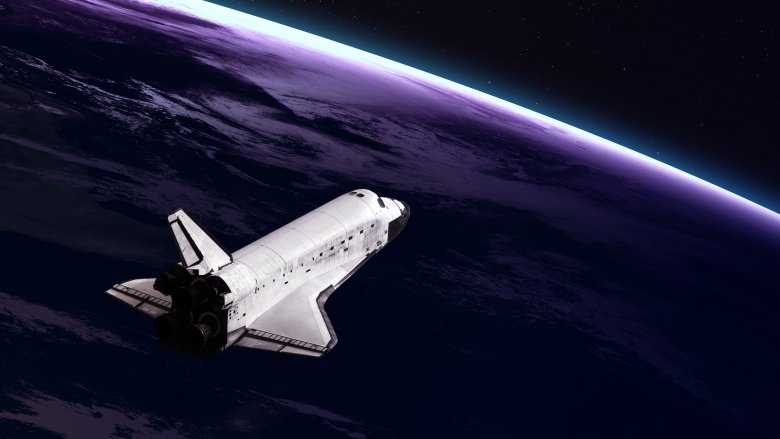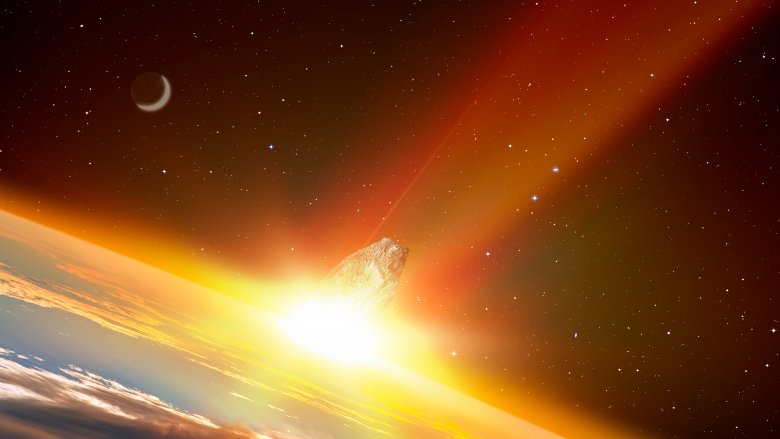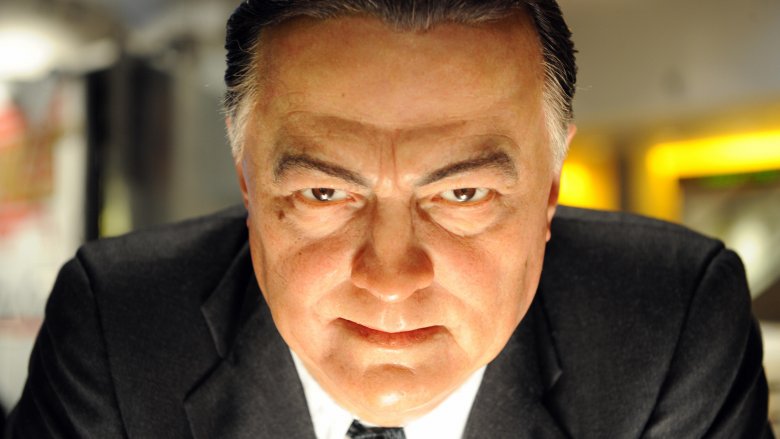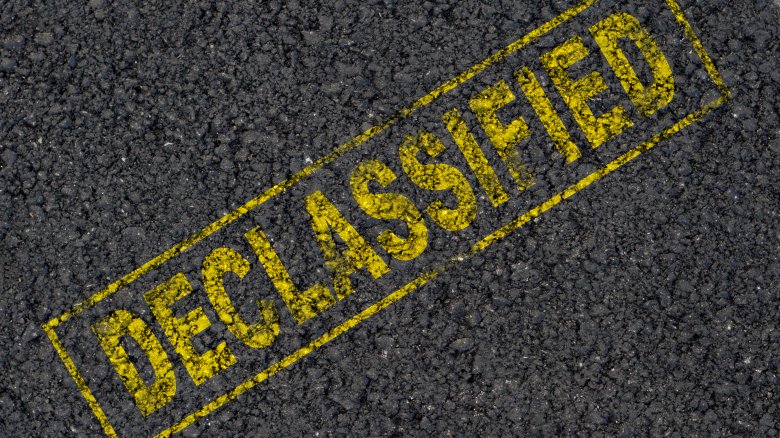The Untold Truth Of Tesla's Death Ray
Nikola Tesla was a lot of things. He was an inventor, a futurist, and a genius. Also he really liked pigeons. And until recently, everyone agreed he probably didn't invent a death ray. Except that he kind of did. FBI documents declassified in 2016 show that the eccentric inventor was working on a "death beam" that would have pretty much made every tank, rocket launcher, battleship, and bomber totally obsolete. So is it a good thing that Tesla died before he could make this sci-fi horror an actual thing? Maybe. Maybe not.
Tesla's death ray was meant for peace
While most Bond villains, upon learning the secrets of building a death ray, would have to put their cats down or risk suffocating them in world-domination-fueled convulsions of ecstasy, Tesla didn't envision a death ray as a way to give certain countries a tactical advantage over every other country.
According to PBS, Tesla hated war, and the death ray was supposed to make it "unthinkable." He considered it an "invisible Chinese wall" that all countries would possess. After all, if your enemy had a weapon that could "bring down a fleet of 10,000 enemy airplanes at a distance of 250 miles," you probably wouldn't send 10,000 airplanes their way. In fact, Tesla liked to think of his idea as a "peace beam," but he was never able to get anyone to finance the thing. He even sent a technical paper to a handful of Allied countries just before World War II and actually got as far as initial testing in the USSR, which despite the whole "peace beam" thing is actually pretty freaking terrifying.
The death ray was a particle beam
Every sci-fi writer knows that if you want to destroy someone, something, or an entire planet, you just hit it with a particle beam. Particle beams are the technology behind everything from Halo's "sniper beam rifle" to Star Trek's "Xindi Superweapon." And lucky for the sci-fi genre, no one really expects writers to solve technical problems like the fact that a particle beam rifle would require a battery too large for its wielder to actually carry around, or that actually firing the thing would probably expose you to enough radiation to either turn you into Doctor Manhattan (unlikely) or just kill you (likely).
As it turns out, Tesla's death ray was also a particle beam. In a Liberty Magazine article published in February 1935, Tesla reportedly explained the idea like this: "My apparatus projects particles which may be relatively large or of microscopic dimensions, enabling us to convey to a small area at a great distance trillions of times more energy than is possible with rays of any kind. Many thousands of horsepower can be thus transmitted by a stream thinner than a hair, so that nothing can resist."
Now the real question is why every nation on the planet didn't try to get into space double-time after hearing about this, because that seems like the most logical way to escape the crazy person and his terrifying invention.
Particle beams can do other things, too
Guess which of these ideas belonged to Tesla, and which are fictional devices used in the plot of a Star Trek episode: 1) A death ray 2) A process for heating upper layers of the Earth's atmosphere that would create an aurora borealis effect in the sky or 3) A device that pumps massive amounts of energy into the Earth, converting it into a sort of high-pressure balloon filled with electricity instead of air. The answer is that those were all Tesla's ideas, although Star Trek did steal the death ray thing once or twice.
If the concept of the mad scientist ever had a poster boy, it was Nikola Tesla. His ideas went beyond practical and into the realm of, "Awesome, but you know, if something went wrong it would destroy the entire planet, or just really annoy a lot of people." Let's take the aurora borealis idea as an example. This was the same technology Tesla envisioned for the death ray, only it would be used to light up the night sky. And who could fail to appreciate the benefits of never being able to see the stars again and having to buy blackout curtains for every room in your house because the concept of night doesn't exist anymore? No one but the people who sell blackout curtains. And never mind the obvious difficulties associated with heating the upper atmosphere ... because climate change just isn't happening fast enough, right?
Death rays make excellent currency
Say what you will about Nikola Tesla, he really didn't give much of a poop who might hear about his potentially world-ending ideas or what those people might do with that information. Tesla didn't really seem to understand the importance of "top secret," which is why he was forever talking about death rays and hundred-billion-watt transmitters. Fortunately, most people thought he was crazy, and there weren't very many who entertained the idea that one squirrelly little dude might be able to annihilate the entire human race.
Fortunately, he never shared any of the deadlier details, though it once looked as if he might be giving away his secrets to some pretty questionable people, namely, hotel management. Toward the end of his life he found himself in significant debt over a hotel bill — according to Mental Floss, Tesla couldn't afford the $20,000 debt he'd accrued while staying at the Governor Clinton Hotel in Manhattan, so he tried to pay the bill with a death ray. He warned management that if they tampered with this very odd bit of currency they might actually explode, which was a pretty ingenious way of making sure they didn't look closely enough at it to learn that it was actually just a pretty box with a bunch of electrical components inside of it. (It wasn't opened until his death.) That's really fine, though, because you never know if an aspiring Bond villain might be working as a bellhop at the Governor Clinton Hotel.
The death ray might have been tested in Colorado Springs
In 1924 the Colorado Springs Gazette proudly proclaimed that "Tesla discovered 'Death Ray' in Experiments He Made Here." Local residents remembered all sorts of freakishly weird events from the 1899 experiments, including a 200-foot pole "topped by a large copper sphere," which sounds absolutely Frankenstein, and evidently was also capable of generating 135-foot lightning bolts. Although there were no reports of reanimated corpses walking the streets, the device did seem to cause other disturbing phenomena, such as sparks that appeared around people's feet, flames that leaped out of kitchen faucets, and butterflies that "helplessly swirled in circles, their wings spouting blue halos of 'St. Elmo's Fire.'"
In those days there was no such thing as electromagnetic hypersensitivity, and there also wasn't any actual accountability for things like mad scientists making flames shoot out of kitchen faucets and creating death ray-charged butterflies, so the events were met with surprisingly little alarm. No one died, no one rose from the dead, and glowing blue butterflies are kind of cool, so no harm done. Tesla did also fry the city's generator, though history doesn't seem to remember whether the inventor had to pay for a new one or if he just stroked a cat and laughed like mad scientists usually do when they destroy infrastructure.
The death ray was not Tesla's first attempt to end war as we know it
Tesla's first anti-war project was ... wait for it ... an RC boat. Yeah, that seems kind of silly on the surface — picture an RC geek driving around a 65,000 ton battleship with two thumbs — but when you think about it Tesla wasn't too far off the mark. Today we have unmanned aerial vehicles, a flying version of what Tesla had in mind, a highly portable weapon that can launch a military strike without putting any human lives on the line.
According to History, Tesla filed for a patent in the late 1800s, but the U.S. Patent Office practically laughed him out of the building. They didn't think the invention would work, so they sent someone out to his lab for a demo. The investigator must have been impressed, because Tesla got the patent in 1898. He sold the idea on its myriad possible uses, from "carrying letters" to "scientific, engineering or commercial purposes," but he clearly also hoped it would be used as a peacekeeping device. "The greatest value of my invention will result from its effect upon warfare and armaments," he wrote, "for by reason of its certain and unlimited destructiveness it will tend to bring about and maintain permanent peace among nations."
Like a lot of Tesla's ideas, this one never got very far, though today it wouldn't be a huge stretch to add "father of drone warfare" to Tesla's rather extensive list of honorary titles.
The death ray brought down the space shuttle Columbia (not really)
Where weird science goes, conspiracy theories follow. Actually conspiracy theories follow just about everyone and anything that's in the public spotlight, but whatever. Anyway because Tesla was into some really bizarre and weird stuff and because the death ray was about as bizarre and weird as it gets, there were lots of people who were always looking out for events that might be death-ray related. So when the space shuttle Columbia broke apart during re-entry in 2003, conspiracy theorists took a break from the whole "the government was responsible for 9/11" thing and switched to "the government was responsible for the space shuttle disaster." Because governments quite often like to destroy their own multibillion-dollar programs.
If you're into conspiracy theories, you can even pick up a whole book on the subject. Entitled "Nikola Tesla's Death Ray and the Columbia Space Shuttle Disaster," the book speculates that NASA engaged in an epic cover-up after a government-owned death ray accidentally (or maybe even intentionally!) brought down the space shuttle. The purported proof: sinister-looking images of the shuttle just before the disaster where "anomalous flashes of purple light" can be seen — photos that were conveniently confiscated by NASA shortly after they were taken. Because it couldn't have possibly been chromatic aberration or anything, and because "death ray" sounds way more plausible than a damaged wing.
And here's another conspiracy theory
Because conspiracy theories are super-fun, here's another one: The Tunguska Event in Russia was caused by Tesla's death ray. In this other tale of things that almost certainly didn't happen, it was not an asteroid that caused the sudden destruction of entire forests near the Podkamennaya Tunguska River in Siberia in 1908 — it was Tesla's death ray. Now never mind that the death ray wasn't even mentioned publicly until 26 years after Tunguska, and that Tesla was sort of busy with propulsion systems and vertical take-off aircraft around that time.
The Tunguska event is pretty much settled — an asteroid roughly 120 feet across exploded over Siberia, producing a blast equivalent to around 185 Hiroshimas. There was no crater because the asteroid never connected with the ground, but the fact that there's nothing pointing to an actual impact is one of the reasons why conspiracy theorists love this story. It doesn't seem to matter that there's approximately zero evidence connecting Tesla to Tunguska, besides the fact that Tesla was Serbian and Tunguska was in Siberia, which sounds kind of like "Serbia." (This is actually more evidence than most conspiracy theories have.) Anyway, the other problem with the whole death-ray-caused-Tunguska idea is that Tesla's death ray, which was supposed to have been housed in Long Island, would have had to go a whole lot further than its 250-mile range to reach Tungaska, but let no fact interfere with a good conspiracy theory.
J. Edgar Hoover got sick of being asked about the stupid death ray
The problem with knowing secrets is people are always asking you to tell them your secrets. Imagine being J. Edgar Hoover in a world full of conspiracy theorists and mad scientist(s), and having to constantly utter the words, "No, we don't have the plans for a death ray."
According to Muck Rock, in 1940, Tesla was getting kind of old and was having trouble paying his bills, so he did an interview with the New York Times, telling them all about his awesome death ray. Naturally, people reading the article were a little alarmed by all the talk of melting airplanes and started writing to the FBI because the idea of such a weapon falling into the hands of enemy governments was pretty freaking terrifying. Spend more than a few minutes imagining Kim Jong-un with a death ray and it won't be long before you've accepted our inevitable downfall and signed up for Rosetta Stone Korean to communicate with our new overlords.
After the initial panic died down, inquiries changed from "do you have the plans for a death ray" to "please give out the plans for your death ray." But after Tesla's death, the now-defunct "Office of Alien Property" took his papers and now no one knows where they are.
The death ray files were declassified in 2016
Because conspiracy theorists totally need to have access to poorly photocopied stacks of cryptic letters and other documents that might somehow confirm some new tenuous link to their ridiculous theories, the FBI declassified the Tesla files in 2016. The story was greedily lapped up by every conspiracy-centered "news" outlet in the known universe, all of which failed to reveal much about the Tesla death ray other than what everyone pretty much already knew: that Tesla "had conducted many experiments in connection with the wireless transmission of electrical power and what is commonly called the 'death ray.'" They didn't really have to wait for the FBI to declassify that information, though. They could have just asked the glowing blue butterfly people in Colorado Springs.
Another shocking revelation: "The government was vitally interested in the effects of TESLA, particularly those dealing with the wireless transmission of electrical energy and the 'death ray.'" This, of course, is shocking only if you think the government is mostly run by magical elves who plan to defend the nation with fairy dust and war unicorns. Of course the U.S. government was "vitally interested" in the death ray because if it really existed it could either destroy America or keep it safe. It would have been irresponsible not to be interested in it.
Tesla was cuckoo
No one can really agree about much when it comes to Nikola Tesla, but most people at least have a consensus about this fact: He had some issues. His diet consisted of mostly bowls of warm milk and pureed vegetables, and he once claimed to love a pigeon "as a man loves a woman," which you really hope was just his inexperience (he never married) talking rather than a confession of something more horrifying than a death ray. He probably suffered from OCD, which wasn't his fault but probably didn't make his life any easier.
The fact that Tesla was a little cuckoo is probably why we don't all live in bunkers and own lifetime subscriptions to Rosetta Stone Korean. If Tesla really had gone beyond a few butterfly-irradiating experiments to an actual, functional death ray, we'd be living in a pretty terrifying world. Fortunately, according to Skeptoid, the fact that Tesla didn't really start talking about the death ray until much later in life, when he was racking up $20,000 hotel bills and courting pigeons, is a pretty good indication that never built a working prototype. Add to that the fact that no one who worked with him ever claimed to have seen such a thing, and most importantly, the fact that the world is still here, and you have some pretty good indicators that we've probably never been in danger of getting vaporized, at least not by a Tesla death ray.
